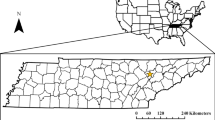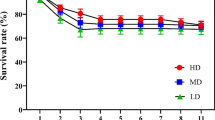Abstract
A spacing experiment for Japanese oak (Quercus mongolica var.grosseserrata) with Nelder's design have been studied at the Kyushu University Forest in Hokkaido, since 1975. The oak seedlings were planted according to systematic spacings which were 20 levels varying gradually from 40,816 to 1,086 seedlings per hectare with concentric circular arcs (22 in number) and spokes (41 in number). In 1992 when the planted oak seedlings were 18-year-old, DBH, crown diameter, total height and clear length of the survival trees were measured. Based on the results obtained from analyzing the relationships between planting density and the mean values of each block, the optimum planting density should be 7,241 seedlings per hectare.
Similar content being viewed by others
Literature cited
Chacko, V.J. (1966) Designs for forestry spacing and thinning experiments. Ind. Forester 92: 61–69.
Imada, M. (1972) Study on the high forest system of mizunara (Quercus crispula Blume). Bull. Kyushu Univ. For. 45: 81–225. (in Japanese with English summary)
Imada, M. (1973) Foundation and application of clear-cutting in the tongue-form blocks surrounded by the cell wall system. Bull. Kyushu Univ. For. 47: 147–164. (in Japanese with English summary)
Imada, M. (1974) Experiment of inducing to sustained yield forest of the structural timber of mizunara (Quercus crispula Blume) (1) The general condition of experiment area and basic plan of inducing. Rep. Kyushu Univ. For. 25: 21–43. (in Japanese with English summary)
Imada, M. (1996) Management system for Japanese oak on the Kyushu University Forest in Hokkaido: 20-year report. J. For. Plann. 2: 43–50.
Nelder, J.A. (1962) New kinds of systematic designs for spacing experiments. Biometrics 18: 283–307.
Tanaka, Y. and Tarumi, T. (1986) Handbook of statistical analysis using personal computer III. Design of experiments. 488pp, Kyoritsushuppan, Tokyo. (in Japanese)
Author information
Authors and Affiliations
Additional information
The title is tentative translation from the original Japanese title by the authors of this paper.
About this article
Cite this article
Imada, M., Kunisaki, T., Mizoue, N. et al. Optimum planting density for Japanese oak (Quercus mongolica var.grosseserrata) based on spacing experiment with systematic design. J. For. Res. 2, 89–93 (1997). https://doi.org/10.1007/BF02348475
Accepted:
Issue Date:
DOI: https://doi.org/10.1007/BF02348475




